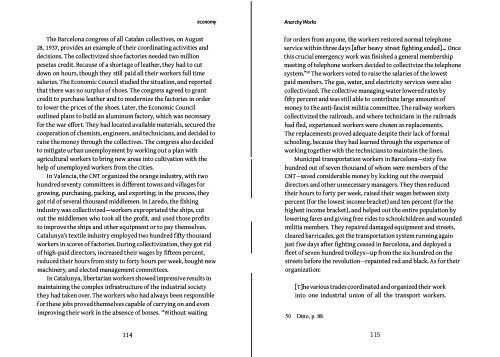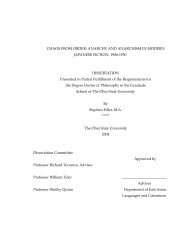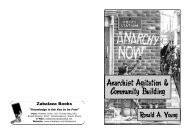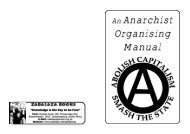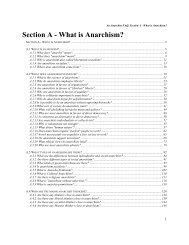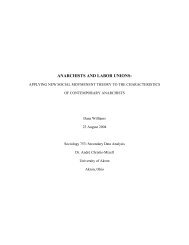Anarchy Works.pdf - Infoshop.org
Anarchy Works.pdf - Infoshop.org
Anarchy Works.pdf - Infoshop.org
You also want an ePaper? Increase the reach of your titles
YUMPU automatically turns print PDFs into web optimized ePapers that Google loves.
economy<br />
The Barcelona congress of all Catalan collectives, on August<br />
28, 1937, provides an example of their coordinating activities and<br />
decisions. The collectivized shoe factories needed two million<br />
pesetas credit. Because of a shortage ofleather, they had to cut<br />
down on hours, though they still paid all their workers full time<br />
salaries. The Economic Council studied the situation, and reported<br />
that there was no surplus of shoes. The congress agreed to grant<br />
credit to purchase leather and to modernize the factories in order<br />
to lower the prices of the shoes. Later, the Economic Council<br />
outlined plans to build an aluminum factory, which was necessary<br />
for the war effort. They had located available materials, secured the<br />
cooperation of chemists, engineers, and technicians, and decided to<br />
raise the money through the collectives. The congress also decided<br />
to mitigate urban unemployment by working out a plan with<br />
agricultural workers to bring new areas into cultivation with the<br />
help of unemployed workers from the cities.<br />
In Valencia, the CNT <strong>org</strong>anized the orange industry, with two<br />
hundred seventy committees in different towns and villages for<br />
growing, purchasing, packing, and exporting; in the process, they<br />
got rid of several thousand middlemen. In Laredo, the fishing<br />
industry was collectivized-workers expropriated the ships, cut<br />
out the middlemen who took all the profit, and used those profits<br />
to improve the ships and other equipment or to pay themselves.<br />
Catalunya's textile industry employed two hundred fifty thousand<br />
workers in scores of factories. During collectivization, they got rid<br />
of high-paid directors, increased their wages by fifteen percent,<br />
reduced their hours from sixty to forty hours per week, bought new<br />
machinery, and elected management committees.<br />
In Catalunya, libertarian workers showed impressive results in<br />
maintaining the complex infrastructure of the industrial society<br />
they had taken over. The workers who had always been responsible<br />
for these jobs proved themselves capable of carrying on and even<br />
improving their work in the absence of bosses. "Without waiting<br />
<strong>Anarchy</strong> <strong>Works</strong><br />
for orders from anyone, the workers restored normal telephone<br />
service within three days [after heavy street fighting ended] ... Once<br />
this crucial emergency work was finished a general membership<br />
meeting of telephone workers decided to collectivize the telephone<br />
system:'50 The workers voted to raise the salaries of the lowest<br />
paid members. The gas, water, and electricity services were also<br />
collectivized. The collective managing water lowered rates by<br />
fifty percent and was still able to contribute large amounts of<br />
money to the anti-fascist militia committee. The railway workers<br />
collectivized the railroads, and where technicians in the railroads<br />
had fled, experienced workers were chosen as replacements.<br />
The replacements proved adequate despite their lack of formal<br />
schooling, because they had learned through the experience of<br />
working together with the technicians to maintain the lines.<br />
Municipal transportation workers in Barcelona-sixty five<br />
hundred out of seven thousand of whom were members of the<br />
CNT -saved considerable money by kicking out the overpaid<br />
directors and other unnecessary managers. They then reduced<br />
their hours to forty per week, raised their wages between sixty<br />
percent (for the lowest income bracket) and ten percent (for the<br />
highest income bracket), and helped out the entire population by<br />
lowering fares and giving free rides to schoolchildren and wounded<br />
militia members. They repaired damaged equipment and streets,<br />
cleared barricades, got the transportation system running again<br />
just five days after fighting ceased in Barcelona, and deployed a<br />
fleet of seven hundred trolleys-up from the six hundred on the<br />
streets before the revolution-repainted red and black. As for their<br />
<strong>org</strong>anization:<br />
[T]he various trades coordinated and <strong>org</strong>anized their work<br />
into one industrial union of all the transport workers.<br />
50 Ditto, p. 88.<br />
114<br />
115


